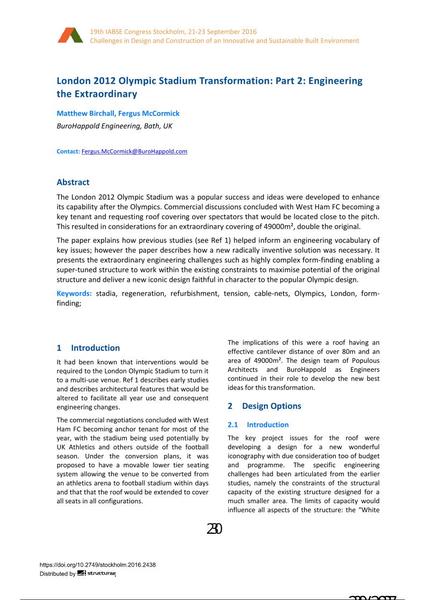London 2012 Olympic Stadium Transformation: Part 2: Engineering the Extraordinary

|
|
|||||||||||
Détails bibliographiques
| Auteur(s): |
Matthew Birchall
(BuroHappold Engineering, Bath, UK)
Fergus Mccormick (BuroHappold Engineering, Bath, UK) |
||||
|---|---|---|---|---|---|
| Médium: | papier de conférence | ||||
| Langue(s): | anglais | ||||
| Conférence: | IABSE Congress: Challenges in Design and Construction of an Innovative and Sustainable Built Environment, Stockholm, Sweden, 21-23 September 2016 | ||||
| Publié dans: | IABSE Congress Stockholm, 2016 | ||||
|
|||||
| Page(s): | 230-237 | ||||
| Nombre total de pages (du PDF): | 8 | ||||
| Année: | 2016 | ||||
| DOI: | 10.2749/stockholm.2016.2438 | ||||
| Abstrait: |
The London 2012 Olympic Stadium was a popular success and ideas were developed to enhance its capability after the Olympics. Commercial discussions concluded with West Ham FC becoming a key tenant and requesting roof covering over spectators that would be located close to the pitch. This resulted in considerations for an extraordinary covering of 49000m², double the original. The paper explains how previous studies (see Ref 1) helped inform an engineering vocabulary of key issues; however the paper describes how a new radically inventive solution was necessary. It presents the extraordinary engineering challenges such as highly complex form-finding enabling a super-tuned structure to work within the existing constraints to maximise potential of the original structure and deliver a new iconic design faithful in character to the popular Olympic design. |
||||
| Mots-clé: |
stades Londres London
|
||||
